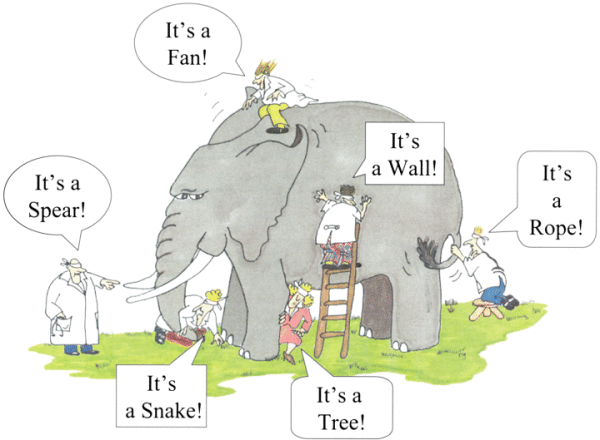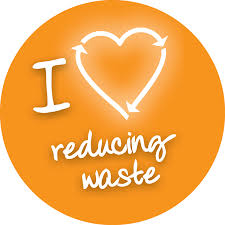 Sometimes the best way to understand what something is is to understand what it is not. I am often asked “what is Lean Six Sigma?” This is a new approach for most educators and administrators and, quite frankly, there’s a lot to understand. In the past, I have used an illustration of six blind men stumbling upon an elephant and each one trying to tell someone what an elephant is. One grabs the tail and says, “An elephant is like a rope.” Another feels the side of an elephant and claims that an elephant is like a wall. Yet another feels the elephant’s tusk and accuses the other two of both being wrong, firmly stating that an elephant is sharp like a spear. So it continues with all six of the blind men. Each blind man was correct; yet, at the same time, each of them was very wrong.
Sometimes the best way to understand what something is is to understand what it is not. I am often asked “what is Lean Six Sigma?” This is a new approach for most educators and administrators and, quite frankly, there’s a lot to understand. In the past, I have used an illustration of six blind men stumbling upon an elephant and each one trying to tell someone what an elephant is. One grabs the tail and says, “An elephant is like a rope.” Another feels the side of an elephant and claims that an elephant is like a wall. Yet another feels the elephant’s tusk and accuses the other two of both being wrong, firmly stating that an elephant is sharp like a spear. So it continues with all six of the blind men. Each blind man was correct; yet, at the same time, each of them was very wrong.
If you ask six Lean Six Sigma experts the question, “What is Lean Six Sigma?,” you may get six different answers. Lean Six Sigma is a problem-solving tool. It is all about engaging your team, it is about eliminating wasteful activity, and so on and so on. Most will tell you about the portions of Lean Six Sigma that appeal to them the most or the portions they have found most useful while applying the approach in certain organizations. Just like the blind men describing an elephant, pointing only to one specific aspect or tool within Lean Six Sigma is to ignore the bigger picture of what Lean Six Sigma is. Keep this idea in mind while considering my list below of five things Lean Six Sigma is NOT; it is greater than these parts.
Lean Six Sigma is NOT….
1. …only about reducing wasteful activities.
People often focus only on the reducing wasteful activity aspects of Lean Six Sigma, only to end up throwing the baby out with the bath water. Lean is about more than understanding waste. Lean is about fully understanding value from the customer’s perspective.
Toyota’s popularity during the gas crisis of the 1970s was not only due to their ability to manufacture a quality vehicle in an efficient manner but also due to their ability to deliver the right vehicle to meet customer needs.
School systems are complex organizations. Value often flows through these organizations in a matrix format – meaning across multiple functions, departments, and individuals – all the way down to students, parents, and communities. Sometimes those functions, departments, and individuals get confused about the true value being created and passed. An example of this is central office staff making high demands of Principals or Teachers and forgetting their role exists to support these same Principals and Teachers.
2. …overly simple or overly complex.
I tell people quite often that Lean is deceptively simple and Six Sigma is deceptively complex. Using the tools together is often done incorrectly. Purists (i.e., experts of only one or another of these tools) will often condemn the other tool set or claim they cannot be adequately combined.
The truth is that specific Lean tools appear to be technically easy but rely heavily on involving and engaging people. This “human” side of the tools, when used correctly, is not always simple to accomplish.
Inversely, when people realize that several Six Sigma tools are based on the practical application of statistics to solve problems, there seems to be a natural aversion to the math. In actuality, so many statistical software tools exist today that do the math for you and make this statistical approach not as difficult as may be anticipated.
Neither tool is overly simple or complex. Both tools working together produce sustainable results over time. An organization can expect two to three years of effort before Lean Six Sigma becomes integrated into the majority of employees’ behavior and the organization’s overall culture.
3. …implementation without people development.
As a Lean Six Sigma Master Black Belt, I talk about processes, value, waste and variation a lot; however, you will find I talk about people more. Deploying Lean Six Sigma tools within an organization means that managing and leading the organization has to change to fit new cultural norms. People will become empowered and must be developed in order to use this new power for the benefit of our end-users (students, parents, and communities). People at all levels will be held at higher levels of accountability and have access to real-time performance data in order to drive incremental improvements. (To learn more about the importance of team member communication and behavior during continuous improvement projects, click here.)
4. …a silver built for all organizational woes.
In 2010, Arne Duncan, the United States Secretary of Education, said, ““I am here to talk today about what has been called the NEW NORMAL. For the next several years, preschool, K-12, and post secondary educators will face the challenge of doing more with less.” Five years later, school systems across the United States are still struggling to acquire the resources they need. At the same time, pressure is mounting to increase the level of academic achievement for students. This has led many school systems to search for a “silver bullet” – the one new initiative, software, or program that can immediately solve all their needs.
In the last few years, we have conducted assessments in over 34 school systems within the Southeast. We have found that several of these districts have made significant investments in technology in hopes of better positioning their school system’s resources. Of these school systems, fewer than 10% are making full use of software and technology, both new investments and those previously existing. Silver bullets do not exist. (Click here for some ideas to consider when considering technology purchases for your school system.)
Lean Six Sigma is no silver bullet. Lean Six Sigma can drive results, improving the availability of resources and increasing value for students, but it requires work. Some projects may have immediate impact, but the long-term advantages do not happen overnight.
5. …applied just like textbooks say, regardless of organization type.
There is no “cookie cutter” approach to applying Lean Six Sigma to any kind of organization. The organization will require a custom blending of the tool set in order to achieve the strongest results. Most people quickly grasp that you cannot apply these tools to schools in the same way you would in a hospital or in manufacturing facilities. Students are neither patients nor products. Knowing how to integrate these tools to fit your organizational needs can be one of the hardest parts.
Misconceptions about Lean Six Sigma in public education abound. I hope by sharing a few things that Lean Six Sigma is not, I have helped clear up some misconceptions. The appropriate application of Lean Six Sigma thinking, tools, and systems in public education can have tremendous results. If you would like to learn more about how Lean Six Sigma can be applied in your school system, “See for Free” with our Lean Opportunity Readiness Assessment (LORA).